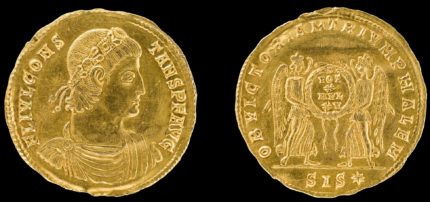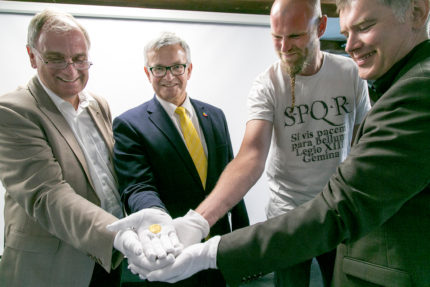A Roman gold coin that is unique in the archaeological record has been discovered by a metal detectorist in the Stade district of Lower Saxony, Germany. Matthias Glüsing was scanning a field near Fredenbeck in December of 2017 when he found the coin. The field is known for its prehistoric burial mounds, but it was significantly northeast of the boundaries of the Roman Empire. The coin was a most unexpected find.
It is a Multiplum of the Emperor Constans, youngest son of Constantine I, and was minted in 342/343 at Siscia in the Roman province of Pannonia Savia. The mint at Siscia, modern-day Sisak, Croatia, was opened by Gallienus in 262 A.D. and remained in use as imperial mint until the end of Gratian’s rule in 383 A.D. The coins struck there during the 4th century bear the mintmark SIS or SISC.
While their obverse and reverse images and inscriptions were derived from high-value circulation coins, multipla were not meant to spend. They were special issues created to commemorate the ascension of a new emperor, a great victory and jubilee years that would be given to a very select group of the emperor’s most loyal supporters in a special ceremony. Holes found in some of the survivors indicate they were worn as pendants by their honored recipients. Very few were made; even fewer survive. None of this type have been found before.
This one was modeled after a gold solidus Constans struck celebrating his victory over the Franks in 342. At nine grams, the Multiplum is twice the weight of the solidus. Its discovery so far north in such good condition may be an indication that it was gifted to a Saxon war leader who gave crucial aid to the Roman emperor. If so, it would be the earliest archaeological evidence of a Saxon military elite in what is now Lower Saxony. While there are references to a tribe north of the Elbe that can be interpreted as “Saxones” in Claudius Ptolemy’s 2nd century Geographia, the earliest undisputed account naming the Saxons comes from a speech delivered by future emperor Julian in 356 A.D. He names them as military allies of the Gallic usurper Magnentius who was acclaimed the new emperor by his troops after they killed Constans. The Multiplum predates that speech (and that alliance).
In recent months, the sensational discovery was intensively researched: At the site an excavation was carried out and searched with metal detectors. In addition, the archaeologists have evaluated historical maps and aerial photographs. “So far, there is good evidence to suggest that the gold coin was sacrificed in a special location characterized by a small moorland, a distinctive burial mound group, an ancient path and an impressive hill,” says [Stade district archaeologist Daniel] Nösler.
Lower Saxony requires that any metal detectorists who wish to search for archaeological materials or who search sites where archaeological materials are likely to be found apply for a permit. All would-be metal detectorists must take a free course to qualify for a permit, and they must contact the archaeologist overseeing the area they plan to explore ahead of time. This system ensures metal detector hobbyists have a proper grounding in how to approach archaeological finds and builds collaborative relationships between the amateurs and the professionals. Indeed, the finder participated in the follow-up archaeological excavation, scanning the wider site for potential areas of interest while archaeologists excavated the find site. Also, he is wearing an excellent t-shirt and I want it.
The coin has been acquired by the government and will go on display at the Stade Schwedenspeicher Museum. The museum has recently opened a new permanent exhibition on the pre-history of the Elbe-Weser-Triangle, and they are going to have to rewrite some of their information in the light of this discovery.

